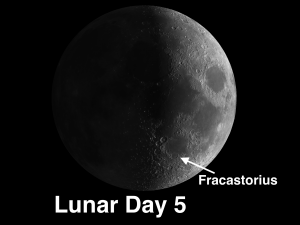 The week of May 29-June 4 takes us from lunar Day 4 through Day 10. This week we will highlight the crater Fracastorius, visible on Tuesday evening.
The week of May 29-June 4 takes us from lunar Day 4 through Day 10. This week we will highlight the crater Fracastorius, visible on Tuesday evening.
Fracastorius: [SE/M13; L=33°E] Located on the south shore of Mare Nectaris, this is one of the Moon’s best examples of subsidence. The Nectaris lavas were so heavy that the floor of Fracastorius actually cracked as it bent downward and allowed the Nectaris lavas to flow over its northern rim. If you’re lucky and have good optics and good seeing, you might actually glimpse the unnamed rille that crosses the floor from east to west just south of the center. There is a tiny 2.5-mi. crater right in the middle of this rille that may help you spot it. (Daguerre on the north shore [L13] and its adjoining unnamed neighbor have both fallen victim to the same process of subsidence.)
There are some quite small objects on the floor of Fracastorius requiring high quality optics and steady seeing. How many of these can you detect? Make a quick sketch, then come back later to compare.
OF ADDITIONAL INTEREST IN SPACE THE WEEK OF MAY 29 – JUNE 4:
On Saturday evening, Jupiter will just be 2° south of the Moon and a multiple moon shadow transit begins at 10:20 PM EDT–and at 11:20 Jupiter’s Great Red Spot will join the show. What a lot of people don’t know is that the GRS has been steadily shrinking. In the late 1800’s it was 35’ wide in longitude (25,000 miles). In 1979 it had shrunk to 21’, and in 2014 it was just 14’ (9,900 miles). The spot is somewhat difficult to see. Try a light-green color filter (a #56 or #58) to increase its contrast.
======================
It is highly recommended that you get a copy of Sky and Telescope’s Field Map of the Moon, the very finest Moon map available for use at the telescope. It is available for $10.95 at www.skyandtelescope.com and on Amazon. All features mentioned in this blog will be keyed to the grid on the Field Map and will look like this: Plato: [NW/D9]
Credits:
Courtesy of Gray Photography of Corpus Christi, Texas
Lunar photos: NASA / USGS / BMDO / LROC / ASU / DLR / LOLA / Moon Globe. Used by permission
- Rupes Cauchy: A Best Known Fault on the Moon - July 22, 2024
- Moon Crater Schickard – Crater Floor has Stripes - July 15, 2024
- Moon Craters Langrenus and Vandelinus - July 8, 2024
